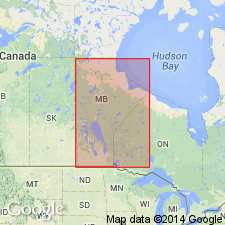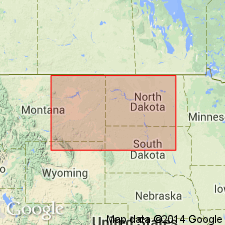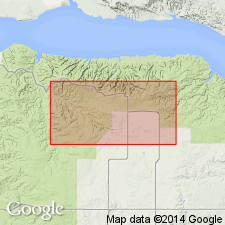
- Usage in publication:
-
- Ashern formation
- Modifications:
-
- Named
- Dominant lithology:
-
- Dolomite
- AAPG geologic province:
-
- Williston basin
Summary:
Named for the village of Ashern, near Lake Manitoba, T25N, RVIE, Manitoba, CN in the Williston basin. No type locality designated. Exposed in scattered outcrops near Lake Manitoba from east shore of Portage Bay south to area just north of Eriksdale, southeast of Dog Lake. Overlies Silurian Stonewall formation; separated from Stonewall by an erosional unconformity. Underlies Middle Devonian Elm Point limestone; separated from Elm Point by an erosional unconformity. Geologic map. Estimated at 0 to 25 ft thick. Consists of brick-red to grayish-orange fossiliferous (gastropods, conodonts), argillaceous dolostone in beds 3 to 12 inches thick. Argillaceous content varies. Ashern rocks were formerly assigned to the Stonewall. May be Silurian or Devonian age. Cross sections.
Source: GNU records (USGS DDS-6; Denver GNULEX).

- Usage in publication:
-
- Ashern formation
- Modifications:
-
- Revised
- AAPG geologic province:
-
- Williston basin
Summary:
Newly assigned as the basal formation of the Elk Point group (rank raised). Unconformably overlies Silurian rocks and underlies Elm Point formation of Elk Point. Upper contact is sharp being marked by thin red claystone beds (Ashern) that are overlain by blue-green clay with iron sulfide and pyrite nodules (Elm Point). Is exposed in a narrow linear strip on northeast side of Devonian outcrops on the Manitoba shelf in MB and SA in the Williston basin. Consists of brown to brick-red, poorly bedded argillaceous dolostone and slightly silty dolomitic shale. Breccia present in lower part. Fossils--cephalopods, gastropods, brachiopods. Correlation chart; cross sections; well-log descriptions. Middle Devonian age.
Source: GNU records (USGS DDS-6; Denver GNULEX).

- Usage in publication:
-
- Ashern Formation
- Modifications:
-
- Areal extent
- AAPG geologic province:
-
- Williston basin
Summary:
Ashern Formation, basal formation of Elm Point Group. Described from subsurface of central Williston basin, North Dakota. Consists mainly of very fine-grained silty and argillaceous dolomite and dolomitic limestone. Locally, very anhydritic. Basal beds are red; the beds become green-gray upwards. Overlies newly named Sherven Formation, upper formation of Interlake Group (rank raised). Probably a subaqueous reworked karst residue that accumulated between Late Silurian and early Middle Devonian time.
Source: Modified from GNU records (USGS DDS-6; Denver GNULEX).
For more information, please contact Nancy Stamm, Geologic Names Committee Secretary.
Asterisk (*) indicates published by U.S. Geological Survey authors.
"No current usage" (†) implies that a name has been abandoned or has fallen into disuse. Former usage and, if known, replacement name given in parentheses ( ).
Slash (/) indicates name conflicts with nomenclatural guidelines (CSN, 1933; ACSN, 1961, 1970; NACSN, 1983, 2005, 2021). May be explained within brackets ([ ]).

